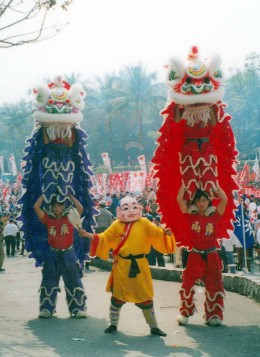Luan Guang Dragon & Lion Dance War Drum Corps. / 兩廣醒獅團
Luan Guang Dragon & Lion Dance War Drum Corps.
By Siang-Ping Zeng
 It could be a New Year celebration, a folk festival, a temple fair, a store opening, a birthday celebration, or even an election campaign. Whatever it is, we can always see bustling, traditional folk performances, such as the Dragon and Lion Dances with war drums. Out of all the performing groups who bring people happiness and preserve traditional skills, Kaohsiung Luan Guang Dragon & Lion Dance War Drum Corps is definitely amongst the greatest.
It could be a New Year celebration, a folk festival, a temple fair, a store opening, a birthday celebration, or even an election campaign. Whatever it is, we can always see bustling, traditional folk performances, such as the Dragon and Lion Dances with war drums. Out of all the performing groups who bring people happiness and preserve traditional skills, Kaohsiung Luan Guang Dragon & Lion Dance War Drum Corps is definitely amongst the greatest.
-◆- The Idea Behind the Dragon & Lion Dances
Hengzong Pei, the troupe's director, first founded the Luan Guang Dragon & Lion Dance Corps in 1975. Later, his son, also the General Coach of Luan Guang, Junqiang Pei, established the Luan Guang Dragon & Lion Dance War Drum Corps in the hope of reaching out to people by introducing to the public, as it does, the troupe's various performances, including the Dragon Dance, and the Lion Dance and war drums. Luan Guang constantly wins both national and international lion dance competitions. The championships won in the First National Lion Dance Competition and the Asian Pacific Lion Dance Competition in Hong Kong, are obvious testimonies to the troupe's superb skill.
-◆- Origin of Dance
General coach, Junqiang Pei, said that both the Dragon and Lion Dances have nearly a two thousand year old history, although there are different opinions as to when they first started. In Chinese culture, the dragon is believed to be able to fly, as well as swim in the sea, thus bringing forth rain and wind. Therefore, the dragon receives great respect from people and is considered a sacred animal. That is why the Dragon Dance symbolizes favorable weather and prosperity. In a Dragon Dance, there is usually a dragon pearl in front of the formation. The dragon will go after the pearl. Throughout the spectacular performance, dragon dancers aptly demonstrate their amazing skill.
The Lion Dance is believed to have originated from Fushan and Heshan in Guangdong, China. After 1945, immigrants from China brought it to Taiwan. There are many different legends as to why people started the Lion Dance in the first place. The most common saying is that people believed that the Lion Dance and the sound of gongs, drums, cymbals and fireworks would drive away the devil as well as monsters. Therefore, whenever there's a festival, lion dancers will go to every residence to wish the inhabitants good luck and drive out the devil by performing the Lion Dance. The drumming previously used at the beginning of a Lion Dance has now been revised and developed into war drums and other drum performances.
Pei has been performing since he was six or seven when he first took part with his father. He recall the time when, in the early years, before the Lion Dance started, the lion dancers would first perform a series of martial arts, boxing and, qigong, for one to two hours. But now the process has been simplified. Nowadays, the dance begins with a Happiness Buddha leading the lion to "grab the green". The so-called "green" usually includes fresh lettuce and red envelopes because "fresh lettuce"(shengcai) sounds exactly like "making money" (shengcai). The lion dancers have to use their own skills to grab the "green" in order to present the good luck and fortune lions traditionally bring to people.
Pei added that in a performance, there is usually a pair of lions. Each lion is played by two dancers. The dancers, occupying the position of the head and tail, need to cooperate with each other perfectly in order to perform a great lion dance. As for the Dragon Dance, a common dragon (with nine segments) will need eighteen to twenty dancers per performance. A set of six drums needs at least twelve performers. Therefore, if a show involves the Lion Dance, Dragon Dance and war drums, it will need at least forty or fifty, and, in some cases, even a hundred people to complete a performance thus creating a spectacular and dynamic sight for the audience to enjoy.
-◆- Challenging Performance
According to Pei, the most exciting and astonishing part of the Lion Dance is when the lions leap onto the poles. He went on to explain that these poles, one or two meters in height, symbolize mountains. While leaping over each "mountain" lion dancers express many emotions the lions may be experiencing such as bravery, surprise, delight, anger, sadness and joy. At the end of the dance, the lion will grab the "green" and unfurl the congratulatory banner to wish the people good luck. Luan Guang has also created a splendid dance called "To the Sky", in which the lion leaps over several extremely high poles.
兩廣醒獅團
文/曾祥屏 傳統的年節喜慶、文化嘉年華會、迎神廟會、開幕、祝壽或選舉等等喜慶的場合,常常可以看見祥龍戲珠,瑞獅呈祥,鼓聲隆隆的舞龍舞獅民俗技藝表演,高雄市「兩廣醒獅團」就是這種增添喜慶氣氛,傳統表演技藝的佼佼者。 高雄市「兩廣醒獅團」是民國64年由裴恒宗團長創立,而裴團長的公子裴俊強總教練,為了讓外界了解團中的表演,包括了祥龍、瑞虎及戰鼓,所以再成立「兩廣龍獅戰鼓團」,兩者可說是二合一的團體;「兩廣醒獅團」是國內、外舞獅大賽、獅王爭霸的常勝軍,曾拿下第一屆總統盃全國舞獅大賽冠軍、香港亞太地區國際舞獅大賽冠軍等10多次奪冠的嘉績。 裴俊強總教練說,舞龍舞獅追溯起來已有1000~2000年歷史,各有不同的傳說。龍,在民間是受尊崇如神祇的動物,能上天下地,呼風喚雨,所以舞龍有祈求風調雨順、國泰民安的意思,舞龍時通常是龍珠在前,透過舞龍追、戲龍珠的過程,展現舞龍的技藝。 而舞獅源起於廣東省佛山與鶴山等地,光復初期隨著移民傳到台灣。舞獅有許多種傳說,通常所說的是舞獅配合鑼、鼓、鈸、鞭炮齊鳴,可以驅逐殘害生靈的怪獸,所以過年過節,到各家戶門前舞獅採青,就有慶賀吉祥和避邪的意思。至於舞獅打的醒獅鼓,串連改編就成戰鼓或祈福的鼓陣。 6、7歲時就跟著爸爸出場表演的裴俊強總教練說,早年舞獅前,團員要先上場表演武術,打拳、氣功演練等約1、2個小時,再開始舞獅子,現在則簡化,只由大頭佛引出獅子「採青」;而所謂「青」,大部份就是新鮮的生菜加上紅包,因「生菜」與「生財」發音類似,舞獅者以本身的功夫與技巧來「採青」,展現祥獅獻瑞的好彩頭,給人們帶來好運及財運。 裴總教練表示,一般舞一頭獅是兩個人,頂獅頭的人要與獅身的夥伴有良好的默契,而一出場通常是一對獅;至於舞龍最基本舞9節龍就要18至20人,打6顆鼓的鼓陣最簡單就要11、12人,舞龍舞獅一起表演就要40~50人甚至要上百人一起演出,規模可以說非常龐大而熱鬧。 裴俊強說,舞獅最精彩的地方是獅子跳梅花樁,就是獅子要在離地面1至2公尺高的樁上跳躍舞動,所謂的「樁」就是山的意思,獅子跳過一座座的山頭,在過程中表現出獅子的的勇猛、驚、疑、喜、怒、哀、樂等等的神態,破除種種難關,最後祥獅採青,從高處垂下祝賀聯,以博得好彩頭;兩廣龍獅戰鼓團還研發出一柱擎天的舞獅,如祥獅攀登高峰,非常精彩。 |